About Ancient Thrace
Now roughly located in Bulgaria Thrace looked small as a territory, yet larger than most kingdoms pf the time, like Macedon, not speaking of the city-states territories. It also had strong potential, with a huge manpower, access to the black sea and valuable ressources including silver, iron and copper. But Herodotus once said that the Thracians that a united Thrace would be the most powerful nation on earth... The fact is, the Thracians were a collection of tribes, a pastoral, agrarian culture, small villages and a few wooden strongholds (póltymbrias) high up in the mountains.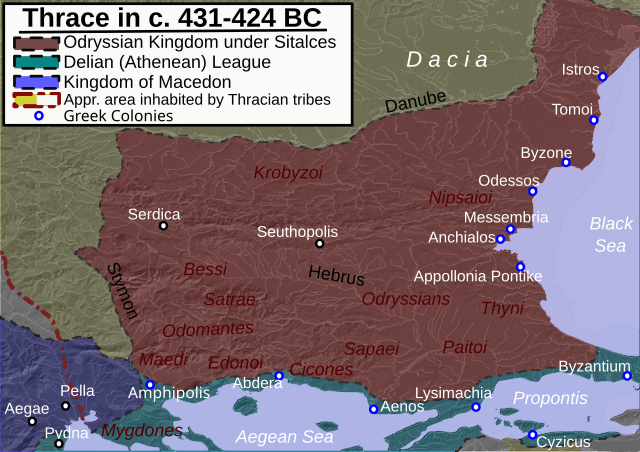
Thracian Map
There were an ancient Indo-European culture, possibly from Asia minor according to bronze age mythology, possibly even one of these famous "sea peoples" that bring down so many prestigious civilizations. Indeed their mythical ancestor was Thrax, son of the war-god Ares. They appeared in Homer's Iliad as Trojan allies, led by Acamas and Peiros. Also in the same Iliad, Rhesus, a local king was noted and Cisseus, father-in-law to the Trojan elder named Antenor, was of Royal Thracian blood. When examining both archeological evidence and ancient texts it also appereared that there were Thracians on both sides of the Hellespont, since centuries of not longer, the Bithynian being related to the Thyni, an important Thracian tribe, perhaps meaning "the second Thyni". Closely associated with the "Thracians" by Homer were also cited the Edones, Bisaltae, Cicones, and Bistones. He also mentioned many kings, among which Diomedes, Tereus, Lycurgus, Phineus, Tegyrius, Eumolpus, Polymnestor, Poltys, and Oeagrus father of Orpheus which acquired sunch an important status in Ovid's Metamorphosis.
Just like the Gauls, Germans, Scythians, etc. the "Thracians" were only defined as such by the Greek, as a collective umbrella for all these tribes that lived in the same area. Their language is understood as very ancient, branching early from the Indo-European tree as Thraco-Dacian, with about 30 known words today whih for some made their way up in Germanic and other languages, and 180 more reconstructed. However Thracian, like Dacian, but also Phrygian, Illyrian, Venetic, and Paeonian could not be categorized with ease, they are "flying" alongside this tree.
 Words like Zeira (cape) and Romphaia (a straight sword), zalmós (cap or pelte hide), Utaspios (Horseman), zibythide (Noble)... When written, Thracian used the Greek alphabet. Greek was the most prevalent influence, to the point that rulers usually were fond of what came from Greece, one of which, Sitalkes, almost succeeded in bringing all tribes under the rule of a single kingdom, Odrysian in the 4th century BC, a bit like the Illyrians under the Dardanian rule. Divided into many tribes of unequal sizes, the mountain Thracians (especially around the Rodhope mount) maintained a strong warrior tradition, whereas the plains thracians were more agrarians, more civilized in a way, like the Odrysians. Their warfare also diverged as the latter used more organized troops, including trained spearmen, and cavalry, while the former relied on skirmishes, short raids of versatile, fast and agile foot warriors. Funeral mounds were dug up recently in Bulgaria that Thracian kings developed a distinct Thracian national identity (State funded, these works are also instrumentalized as often for nationalistic purposes). According to Herodotus they had many customs, and a common religion. Being branded for example was a symbol of prestige, not infamy. Other customs are more discutable as always with Herodotus, for sensationalist effect towards his Greek audience.
Words like Zeira (cape) and Romphaia (a straight sword), zalmós (cap or pelte hide), Utaspios (Horseman), zibythide (Noble)... When written, Thracian used the Greek alphabet. Greek was the most prevalent influence, to the point that rulers usually were fond of what came from Greece, one of which, Sitalkes, almost succeeded in bringing all tribes under the rule of a single kingdom, Odrysian in the 4th century BC, a bit like the Illyrians under the Dardanian rule. Divided into many tribes of unequal sizes, the mountain Thracians (especially around the Rodhope mount) maintained a strong warrior tradition, whereas the plains thracians were more agrarians, more civilized in a way, like the Odrysians. Their warfare also diverged as the latter used more organized troops, including trained spearmen, and cavalry, while the former relied on skirmishes, short raids of versatile, fast and agile foot warriors. Funeral mounds were dug up recently in Bulgaria that Thracian kings developed a distinct Thracian national identity (State funded, these works are also instrumentalized as often for nationalistic purposes). According to Herodotus they had many customs, and a common religion. Being branded for example was a symbol of prestige, not infamy. Other customs are more discutable as always with Herodotus, for sensationalist effect towards his Greek audience.
During this period, a subculture of celibate ascetics developed, later also present with the Getae or "Northern thracians", and passed on to the Dacians (now Romanians). These were the Ctistae, philosophers, priests and prophets, with the same aura and prehaps the same duty than Celtic druids. Southern Thrace started to become hellenized before the Peloponnesian War when a single kingdom seemed to have tamed the Thracians, inducing some renewed interest from Greece, notably peace and trade treaties which favoured these exchanges. Athenian and Ionian colonies also appeared at that time before the Pelopponesian war. Thrace also fell to the Persians, during the largest extent of the Empire and made frequent apparitions as Persian troops. Warfare eveolved wth the use of the Akinakes, a Scythian dagger for close combat. Prior to that, Seuthopolis became the de facto capital of Thrace, covered with prestige stone buildings and large straight streets in the Greek fashion. Temples were dedicated to the Bessi god Dionysus (Bacchus) and Bendis. Zagreus (pre-Dionysus) was also worshipped by followers of Orphism. Mysteries were also dedicated to Dionysus (Dionysii) the Bacchanalia known in Thrace as Rozalii. Orphic mysteries were performed by by devoted unmarried men ("a-bii"), held in secret places and comprising by choral songs and mimic games. The symbolic death of the king-priest identified with Zagreus was also a strong ceremonial. Bendis was a goddess worshiped in Southwestern Thrace, a hunter, wrapped with leather with boots and a fox fur hat, holding a spear, bow or net and hunting dog. The Bessi cult included wine and fumigations with a flower, Haberlea rhodopensis to cause euphoria, pouring wine on the altar and observing the height of the blaze, and potentuially a sacrificial animal.
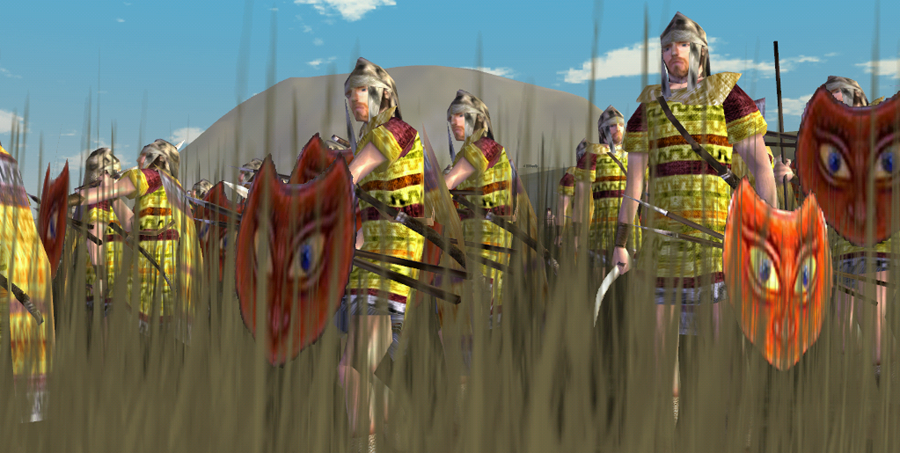
Spartan and Doric colonists also settled on the coast after the war, due to their victory(with Persian gold). But Athens was particualrly active with this bondage with Thrace, underlined by the numerous finds of Athenian silverware in Thracian tombs. It was possibly the result of Greek craftsmanships for Thracian nobles a bit like the Scythians in Bosporos.
Thrace was also a conveted prize for Macedon, and during Philip II of Macedon's decisive rule, he really ironed up his levied forces in contact to the nearest bellicose tribes, which used to launch raids of pillaging and rampaging through his kingdom. In one battle in particular to subdue the Triballi, he nearly died in combat. But it is noted their use of long spears perhaps inspired him the sarissa. This is a reflection that in short, the "peltastai" was basically a pelte bearer, with javelins, and other weapons, either an Akinakes, Axe, club, sword, sica, or spear. It all depended on the wealth of the owner, own style of combat, bravery (Like the Celts, the Thracians were likely to reuse captured equipments, either helmets, greaves and swords). To be sure, if disciplined, a combined use of these various elements could have been absolutely devastating (see about the Triballi). The Thracians were soon used as mercenaries by Alexander of Macedon, a convenient way to funnel their natural warlike tendencies by promises, in addition to immediate gold, to plundering the rich cities or Persia, they probably knew from generations of occupation. They were used alongside the Greek peltasts, but probably not mixed together for cultural reasons and esprit de corps. One of these mercenary tribes reputed throughout Alexander's campaign and distinguished for that, were the Agrianes, which became noted as an homogeneous, elite unit.
Elite Peltasts: The Agrianes

A map locating the Agrianes. This people was immediately north of Macedon and well placed in the valley that directly conducted in Macedonia. So they were likely to have been fough over many times, by Alexander, his father and his own father, grand-father and great-grand-father. It's therefore logical they had been contacted first as mercenaries. Being mountaineers they were noted as peltastai. Also called Agrianians, this tribe was located at the Upper Strymon, the bondary between central Balkans and Thrace, north of the Dentheletae, another tribe. Philip II eventually subjugated them, and the territory was administered from Pella. They were noted as crack javeliners, considered as an elite unit of Alexander the Great's light infantry, under command of General Attalus (which would later fund the Pergamese kingdom). They were tribe related to the Paeonians, together with the Odomanti and Doberes and are described only by Theopompus in detail.
First mentioned in Megabazos' campaign in 511 BC, by 429 BC they became part of the Odrysian kingdom and in 352 BC, became allies of King Philip. Their use as allied troops against other Thracians, of better to motivate them, Greek city-states, began there. They were led by king Langarus as allies against the Triballians in 335 BC, even protecting Prince Alexander lands, and were thus rewarded in a personal way by the young King later with the right to govern themselves. This was the start of a long-lasting and reliable alliance. At the Battle of Gaugamela in 331 BC these Agrianes were noted as about 1,000 men. The Seleucid Empire also used them, as a crack unit, brigaded together with Persians at the battle of Raphia. Agrianes and Penestae, numbering 800 and 2,000 men respectively were stationed at Cassandreia when the Third Macedonian War broke out. They were generally considered as and elite light infantry of the Macedonian army, covering the right -most vulnerable- flank of the battle line, and right of the Companion cavalry, a position of honour. They were always mustered when speed of movement was required. These were armed with javelins and a sword, had the typical light shield but no armour, and sometimes helmets. They usually adopted an open order when facing enemy heavy infantry, throwing their javelins at will and evade any counter-charge. But like other Psiloi, they were vulnerable to medium and heavy cavalry, with the advantage of escaping on broken ground. There is little doubt they were the main inspiration for Greek mercenary peltasts, but also perhaps of the "Royal Peltasts", probably Hypaspistai converted as skirmishers on the battle line.
By 168 BC, after the Third Macedonian war, Macedonia fell to the Romans, Thrace also lost its independence and became tributary to Rome and passed from a client kingdom state with Roman-appointed kings Roman province (Romana provincia Thracia) in 46 AD.
"Kingslayers": The Triballi
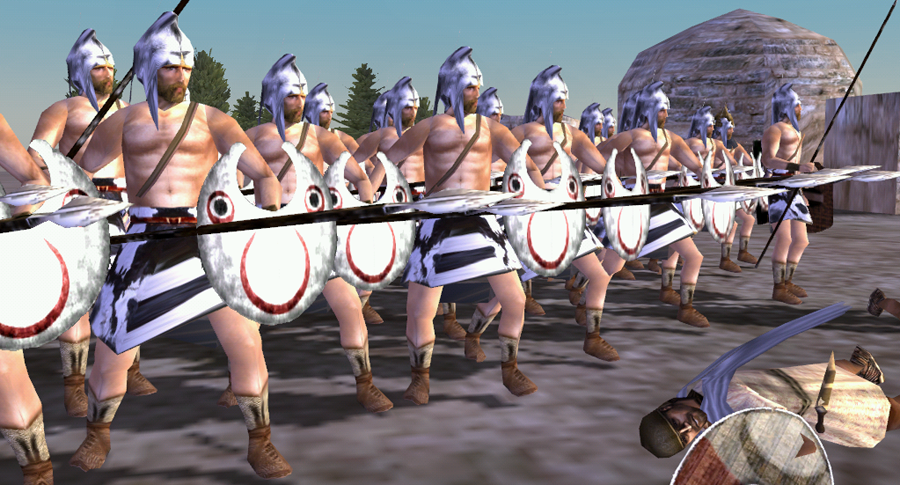
The Triballi were another Thracian tribes well known by Philip II, but as a reckless foe. Fiercely independent, this important people known from 800 BC (Greek: Τριβαλλοί, Triballoí)) were apparently quite efficient, almost having the reputation of kingslayers: They killed in 424 BC King Sitalkes, of the Odrysae, ending the dynasty and kingdom, the only attempt to unify the Thracians. In 376 BC a large force under King Hales crossed Mount Haemus and advanced as far as Abdera and were about to besiege it when Athenian general Chabrias appeared off the coast and organized a reconciliation. Most importantly in 339 BC, Philip II of Macedon was returning from his expedition against the Scythians. His way home was blocked by the Triballi, asking for a share of the booty for right of passage, faltly refused. In a pitch battle that followed, Philip was defeated and grievly wounded by a spear in his right thigh, making him limp for the rest of his days. He would later subdue them. Alexander himself fought them in three battles, Haemus, Lyginus river, and Peuce Island, until they were driven off to Peuce Islands. There, all the remanants of Thracian tribes took refuge, led by king Syrmus. Meanwhile, Alexander "cleaned up" the Danube of their presence with the utmost brutality, to the point thet they eventualy sued for peace and were subdued. The Triballi were eventually beaten and pushed further east by the Autariatae and Celts in 295 BC. Later, the extreme punishment of Ptolemy Keraunos on the Getae had them sue for peace. The final blow came when they were attacked by the Gallic chieftain Cerethrius defeated them comprehensively with an army of 3,000 horsemen and 15,000 foot soldiers in 279 BC. Later on, whereas the Triballi took refuge further east, the Celts would create a new Kingdom in Tylis. Their former lands were occupied by the Illyrian Dardani tribe and during the Empire, and until 168 AD they are still mentioned at times.
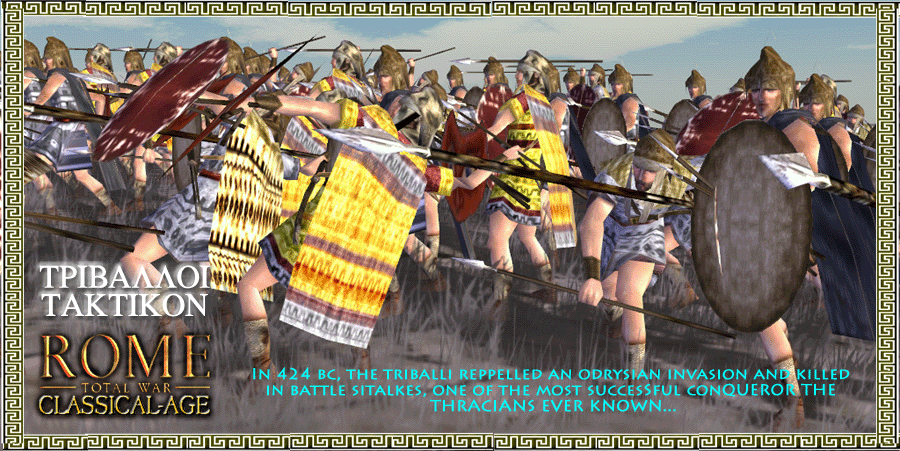
One crown to rule them all: The Odrysians
The famous kingdom was the only attempt to unite all Thracian tribes. The Odrysioi/Odrusai (Ὀδρύσαι) was the largest, most advanced and powerful kingdom of the plain Thracians. As said above, they were more "peacable", lettered (for the nobles), an agrarian civilization with villages and embryos of city-states that took model on the Greek Emporio on the coast of the Black sea. They were spread far and wide on the plain of the Hebrus river, and their power resided apparebtly in their ability to fight in pitch battles with discipline and combined tactics using cavalry and heavy infantry, possibly trained by Greek officers; They were described as a people by Herodotus, first, but also Xenophon (about their horse races and drinking habits at burials) and also Thucydides (On the gifts cutoms for getting things done). Perhaps their army was shaped first by their occupation by the Persian empire from 516 BC, the Skudra satrapy, of which the eastern part was later occupied by Scythians and Greek colonists. Unification process began with King Teres in the 470s BC after the Persian defeat in Greece, and his successor Sitalces made the Odrysian the state a strong kingdom extending from the Black Sea to the east, and Danube to the north. Their greatest foe became the Triballi to the north-west. Their influence also reached the basin of the river Strymon to the south-west and the Aegean. However Hegemony was difficult to maintain and is not well recorded. This very large territory encompassed Thracian and Daco-Moesian tribes, trying to overcome the tribal divisions and stablishing a common sense of belonging, based on cultural bonds. This was however a near-feodal system with intra-tribal elites holding local military power. In 429 BC, Sitalces allied himself with the Athenians and raised a considerable army to wage war on the Macedonians. He led a campaign with coalized Thracian and Paeonian tribes numbering (according to Thucydides) some 150,000 men. The Nobility back then used to talk Greek to be understood by other tribes, and the Greek alphabet was adopted to have everything registered; Eventually in the IVth century BC, the Kingdom split into three parts, which coincided with the rise of Macedon. Philip II was able indeed to profit of this divisions to conquer the kingdoms one by one and subjugated nearly all of Thrace.
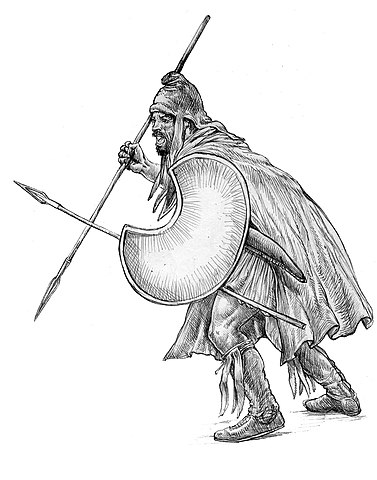 A common depiction of a Peltastai of the V-VIth Centuries (wikimedia, drawing by Dariusz t. Wielec). The Pelte, litteraly means "pelt" generally designateda small shield made of hide on a light wooden armature, either wicker or assimilated. It could have been however also a fully wooden shield covered by a pelt, later painted for best effects with frightening heads, and various symbols, either symbolic or sacred. It is quite possible that the motives and colors, elbeit personalized (as an example, symbols for those killed in combat by the owner) would be used as to diffetenciate friends from foe among warring Thracian tribes, as well as the tunic and Zeira patterns and colors, which were vivid, far from the ornemental "good taste" of the Greeks, and a further way to distinguish the "Barbarians".
A common depiction of a Peltastai of the V-VIth Centuries (wikimedia, drawing by Dariusz t. Wielec). The Pelte, litteraly means "pelt" generally designateda small shield made of hide on a light wooden armature, either wicker or assimilated. It could have been however also a fully wooden shield covered by a pelt, later painted for best effects with frightening heads, and various symbols, either symbolic or sacred. It is quite possible that the motives and colors, elbeit personalized (as an example, symbols for those killed in combat by the owner) would be used as to diffetenciate friends from foe among warring Thracian tribes, as well as the tunic and Zeira patterns and colors, which were vivid, far from the ornemental "good taste" of the Greeks, and a further way to distinguish the "Barbarians".
Northern Thracians: The Getae
Called Getai (Greek) or Getae (Latin), these northern Thracians living on the coast of the black sea were soon so influenced by the nearby Scythians they adopted much of their attributes, trousers, pointed caps and shoes, boots, status-enhancing tattoos and artwork largely influenced either by Persian or Greek but also Greco-Scythian art. The Triballi to the west also gradually adopted Celtic equipement and wore trousers. Archery became a very important part of warfare for the Getae, which armies comprised an unsual number of horse archers, light and armoured. The whole artistocracy was made also of elite horsemen. The peasantry (later known by the Dacians as the "Komatai") did not had the right to wear a cap, contrary to the nobility (Tarabostai). They wore high quality hemp, flax or wool garments, brightly colored jackets, but the nobility, which spoke Greek fluently was very fond of Greek hardware, armour, weaponry and helmets. They were several Thracian tribes that once inhabited the regions to either side of the Lower Danube, "Get" being a Greek exonym related to their location. This exonym led to the designation of several groups or tibes named Tyragetae, Thyssagetae, and Massagetae. The latter were nomadic tribes which lived beyond the eastern black sea coast. Thracian/Getai cavalry was proficient in using wedge, a Scythian tactic, and Getai horse archers adopted the akinakes, saddles horse archer equipment, even Scythian type helmets (Which were often Chalcidian models with straps to attach a leather neck protection). The famous Dacians (Daioi) of the north-west were related to them (same language, similar culture, warfare, etc.). They will rise to fame in the first year of the Empire by building a massive empire comprising forme Thracians, Celts, Sarmatians, Marcomanni and others in a massive colation, leading to the Trajanic wars.In a nutshell: The Thracian peltast
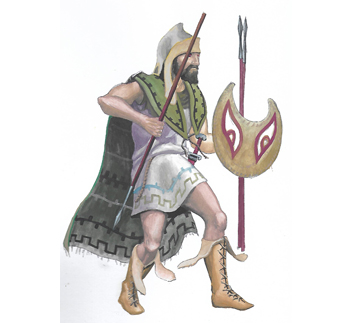 A typical Thracian peltast. A textbook one, as described by authors, starting with Herodotus, with the tunic, boots, crescent-shaped Pelte, javelins, sword, Zeira, and cowhide cap. These are all attributes fit for a light, mobile and agile light infantry, the core of mountain tribes infantry which were experts in skirmishing. It is in no way a kind of infantry fit for a prolongated open-air pitch battle. They obviously lack protection, and are easy prey for the cavalry. The only benefit they bring in battle is their fierce reputation and close-quarter combat expertise which the Psiloi lacks. Psiloi are, as a remainder, either shepherds (slingers), Peasant youth (akontistai) or Foresters (Toxotai). The Thracians add to this their warrior ethos and skills.
A typical Thracian peltast. A textbook one, as described by authors, starting with Herodotus, with the tunic, boots, crescent-shaped Pelte, javelins, sword, Zeira, and cowhide cap. These are all attributes fit for a light, mobile and agile light infantry, the core of mountain tribes infantry which were experts in skirmishing. It is in no way a kind of infantry fit for a prolongated open-air pitch battle. They obviously lack protection, and are easy prey for the cavalry. The only benefit they bring in battle is their fierce reputation and close-quarter combat expertise which the Psiloi lacks. Psiloi are, as a remainder, either shepherds (slingers), Peasant youth (akontistai) or Foresters (Toxotai). The Thracians add to this their warrior ethos and skills.
Thracian mercenaries were praised for their ferocity in battle, and played an important role during the "world war" between Athenians and Spartans. The Odomantii in particular were described as expensive mercenaries. The Dii were even so expensive to pay that by 413 BC they were explused back home by the Athenians, using their own ships. The Persians also hoired them, like Croesus, a Lydian general. The Republican Roman and Pontic armies also hored some and of course the Diadocii. To that point that they amounted to 1/5 of the footsoldiers of the Macedonian army in the Hellenistic era, mostly as allies. Also a reflection of their population and love for war, they later formed certainly one of the most important nationality of the Imperial Roman army, up to 20,000 auxiliaries. The Greeks made good use of their reputation. The Dii in particular, after a siege ended, were let loose into the city as a punishment, not only sacked and pillaged the cities of Tanagra and Mycalessos, but also "killed all living beings inside the walls", men, women, children and even dogs. They were decribed by the authors as warlike, ferocious, and savagely bloodthirsty, wild, savage, impatient, disobedient, disloyal, and greedy, but also extravagant and high spirited. They were heavy drinkers (a common occurence from the supposedly moderate Greeks), prone to in-fighting for any pretext, and were proficient in night raids, also a "dishonorable way of war", also stricking their weapons against each other before battle, or impaling the heads of their enemies on their frightful Rompahias (Callinicos skirmish, 171 BC). Their reputation was such, an Athenian club for lawless youths was named the Triballi.
Influence
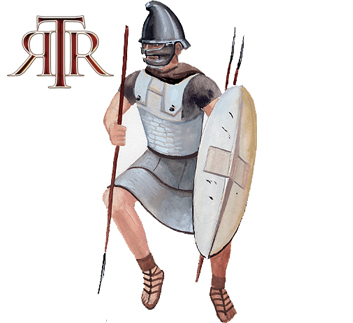 Right: A heavy peltast of the Hellenistic period. This is a kind of late Greek mercenary showing attributes long derived from the Thracian peltast, but which predated the Thureophoroi. Instead of boots, Greek sandals, no greaves (but many have some), a hardened leather/textile/metal composite light body armor, a Thureos, built like a Pelte, a Thracian helmet, typical with its Phrygian style and protective mask. Not seen there, this peltast also carries a Greek sword, probably more a Kopis than a shorter machaira, better suited to a very close-quarter combat in a phalanx line; Heavy peltasts were mainstream in hellenistic armies and the Thureophoroi developed as a versatile infantry carrying out a spear in addition to javelins and sword is probably the recoignition this kind of medium infantry is the missing link between the phalanx and proper peltasts and light infantry (Psiloi) in general.
Right: A heavy peltast of the Hellenistic period. This is a kind of late Greek mercenary showing attributes long derived from the Thracian peltast, but which predated the Thureophoroi. Instead of boots, Greek sandals, no greaves (but many have some), a hardened leather/textile/metal composite light body armor, a Thureos, built like a Pelte, a Thracian helmet, typical with its Phrygian style and protective mask. Not seen there, this peltast also carries a Greek sword, probably more a Kopis than a shorter machaira, better suited to a very close-quarter combat in a phalanx line; Heavy peltasts were mainstream in hellenistic armies and the Thureophoroi developed as a versatile infantry carrying out a spear in addition to javelins and sword is probably the recoignition this kind of medium infantry is the missing link between the phalanx and proper peltasts and light infantry (Psiloi) in general.
Influence on Greek and Hellenistic warfare was considerable. It shown there was a kind of light infantry that was skilled and well equipped enough to be used in melee combat, after playing its traditional skirmisher role. Both the heavy peltast and the thureophoroi were explorations of this kind of infantry, that derived to a medium one after better equipped and professional Peltasts from the Greek world took over, as this was a cheaper equipment than hoplitic, and in the Peloponnesian war and especially in the Hellenistic worlds, "Peltastai" became a byword for mercenary. It was not implied these were Thracians. The Thracians themselves, in contact with the Greek world, became a bit heavier, with helmets and greaves being more common, using ovoid, thick all-wooden shields sometimes covered with bronze, and a romphaia, by then the most frighful weapon they can muster. We will go back on this one when studying Thracian warriors in the Hellenistic period. They could have been named "peltastai" as an extension or generalization, but did have little on common with the Thracian tribesmen of old.
Sources/Read More
Thracian warfareOn bulgariawinetours.com
Thrakian Infantry and Cavalry (Catw)
Thracian language
The Thracians 700 BC-AD 46 (Men-at-Arms)
♕ Aquitani & Vasci ♕ Celts ♕ Indo-greeks ♕ Veneti ♕ Yuezhi ♕ Indians ♕ Etruscans ♕ Numidians ♕ Samnites ♕ Judaean ♕ Ancient Chinese ♕ Corsico-Sardinians
⚔ Cingetos ⚔ Immortals ⚔ Cavaros ⚔ Cataphract ⚔ Romphaiorioi ⚔ Chalkaspidai ⚔ Devotio Warrior ⚔ Scythian Horse archer ⚔ The Ambactos ⚔ Iberian warfare ⚔ Illyrian warriors ⚔ Germanic spearmen ⚔ Carthaginian Hoplite ⚔ Thracian Peltast ⚔ Caetrati ⚔ Ensiferi ⚔ Hippakontistai ⚔ Hastati ⚔ Gaesatae ⚔ Cretan Archer ⚔ Thorakitai ⚔ Soldurii ⚔ Iphikrates ⚔ Kardaka ⚔ The thureophoroi